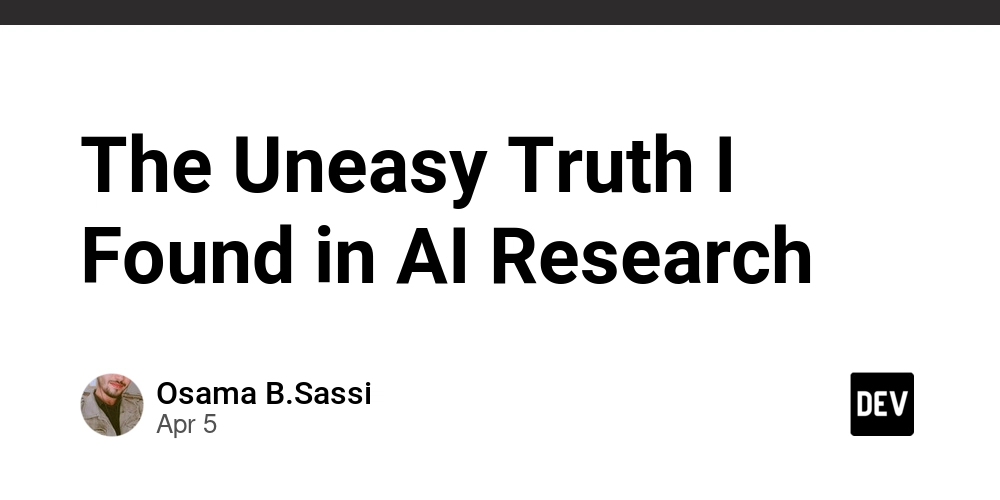The Uneasy Truth I Found in AI Research
As I'm currently working on my graduation project , focused on emotion classification and intention inference using the DEAP dataset, I've noticed something happening in related research papers that has made me concerned. While looking at different ways to do this kind of work, I've seen a pattern that worries me about how some AI research is being done. It's perfectly valid for research to explore "subject-dependent" approaches in areas like emotion recognition, and many papers clearly state this limitation. If a study focuses on understanding emotions within a specific group and acknowledges that its findings might not directly apply to others, that's transparent and scientifically sound. The problem arises when papers boldly claim their method is "subject-independent" suggesting it should work well for any individual, but then employ evaluation techniques that fundamentally undermine this claim. The most common example I've encountered is the use of a simple train_test_split (often something like 70% train, 30% test) on the entire dataset, while still asserting subject independence. We know that with such a split, data from the same individuals can easily end up in both the training and testing sets across different iterations. While the model might not see the exact same data points during testing, it has likely learned patterns specific to those individuals during training. Therefore, the reported accuracy, even if high (like a misleading 90%), doesn't truly reflect how well the model would perform on someone it has never encountered before. This isn't genuine subject independence; it's a form of data leakage that inflates performance metrics and misrepresents the model's true generalization ability. This isn't just a minor oversight; it feels like a subtle form of "faking" generalization. By not employing rigorous subject-independent evaluation methods (like leave-one-subject-out cross-validation or training on a completely separate dataset), these papers present a potentially inflated and unrealistic picture of their model's capabilities. This is particularly troubling because it can mislead other researchers and practitioners about the actual state of the field. Why does this misrepresentation matter? It creates a false sense of progress. Developers might invest time and resources trying to implement "subject-independent" solutions based on these inflated claims, only to find they don't perform as advertised in real-world scenarios with new users It also undermines the credibility of AI research when such fundamental methodological flaws are overlooked or, perhaps, intentionally ignored. In conclusion, as I continue on my path towards a PhD, I want to assure that honesty and transparency will be paramount in all my research endeavors. I am committed to ensuring that any scientific paper I publish will offer genuine value and contribute meaningfully to the field, rather than serving merely as a superficial attempt to appear as a researcher. So, I urge fellow researchers and developers to look beyond the headline accuracy numbers and carefully examine the evaluation methodologies used. Let's encourage a culture of honest reporting and rigorous validation to ensure that our progress in AI is built on a solid and truthful foundation.

As I'm currently working on my graduation project , focused on emotion classification and intention inference using the DEAP dataset, I've noticed something happening in related research papers that has made me concerned. While looking at different ways to do this kind of work, I've seen a pattern that worries me about how some AI research is being done.
It's perfectly valid for research to explore "subject-dependent" approaches in areas like emotion recognition, and many papers clearly state this limitation. If a study focuses on understanding emotions within a specific group and acknowledges that its findings might not directly apply to others, that's transparent and scientifically sound. The problem arises when papers boldly claim their method is "subject-independent" suggesting it should work well for any individual, but then employ evaluation techniques that fundamentally undermine this claim.
The most common example I've encountered is the use of a simple train_test_split (often something like 70% train, 30% test) on the entire dataset, while still asserting subject independence. We know that with such a split, data from the same individuals can easily end up in both the training and testing sets across different iterations. While the model might not see the exact same data points during testing, it has likely learned patterns specific to those individuals during training. Therefore, the reported accuracy, even if high (like a misleading 90%), doesn't truly reflect how well the model would perform on someone it has never encountered before. This isn't genuine subject independence; it's a form of data leakage that inflates performance metrics and misrepresents the model's true generalization ability.
This isn't just a minor oversight; it feels like a subtle form of "faking" generalization. By not employing rigorous subject-independent evaluation methods (like leave-one-subject-out cross-validation or training on a completely separate dataset), these papers present a potentially inflated and unrealistic picture of their model's capabilities. This is particularly troubling because it can mislead other researchers and practitioners about the actual state of the field.
Why does this misrepresentation matter? It creates a false sense of progress. Developers might invest time and resources trying to implement "subject-independent" solutions based on these inflated claims, only to find they don't perform as advertised in real-world scenarios with new users
It also undermines the credibility of AI research when such fundamental methodological flaws are overlooked or, perhaps, intentionally ignored.
In conclusion, as I continue on my path towards a PhD, I want to assure that honesty and transparency will be paramount in all my research endeavors. I am committed to ensuring that any scientific paper I publish will offer genuine value and contribute meaningfully to the field, rather than serving merely as a superficial attempt to appear as a researcher.
So, I urge fellow researchers and developers to look beyond the headline accuracy numbers and carefully examine the evaluation methodologies used. Let's encourage a culture of honest reporting and rigorous validation to ensure that our progress in AI is built on a solid and truthful foundation.












































































































































































![[The AI Show Episode 142]: ChatGPT’s New Image Generator, Studio Ghibli Craze and Backlash, Gemini 2.5, OpenAI Academy, 4o Updates, Vibe Marketing & xAI Acquires X](https://www.marketingaiinstitute.com/hubfs/ep%20142%20cover.png)



























































































































![[DEALS] The Premium Learn to Code Certification Bundle (97% off) & Other Deals Up To 98% Off – Offers End Soon!](https://www.javacodegeeks.com/wp-content/uploads/2012/12/jcg-logo.jpg)


![From drop-out to software architect with Jason Lengstorf [Podcast #167]](https://cdn.hashnode.com/res/hashnode/image/upload/v1743796461357/f3d19cd7-e6f5-4d7c-8bfc-eb974bc8da68.png?#)








































































































.png?#)

































_Christophe_Coat_Alamy.jpg?#)
 (1).webp?#)





































































































![Apple Considers Delaying Smart Home Hub Until 2026 [Gurman]](https://www.iclarified.com/images/news/96946/96946/96946-640.jpg)
![iPhone 17 Pro Won't Feature Two-Toned Back [Gurman]](https://www.iclarified.com/images/news/96944/96944/96944-640.jpg)
![Tariffs Threaten Apple's $999 iPhone Price Point in the U.S. [Gurman]](https://www.iclarified.com/images/news/96943/96943/96943-640.jpg)




































































































































